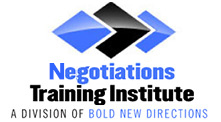Written by Jim Hornickel
There are lots of areas of importance in a negotiation. This article will focus on the value of being clear about the 5 parts to creating and staying with an effective range. What is a range? Many negotiators focus only on the monetary aspect when thinking about their range. We encourage using this same principle in any area in which concessions will be traded. In addition to a range for dollars, additional examples for application are: service hours included, delivery times, percentages… Be creative! And, always think mutuality-based, win-win.
Here are the five interactive areas that make up the range:
1. Power of the WISH:
A range has a top and bottom to it. Many negotiators on either side of the sale start with a figure that is too low. Example – Selling a House. The seller creates a range of asking $350,000 to the bottom line of $335,000. The way the Wish works is to think outside the box of reason when doing the preparation: this figure is never revealed to the other party. In the ideal world, what could you get for the house? “Ah, I would really like to get $375,000!” Well that is a little unrealistic but now he/she is thinking bigger. They may now start their range at $360,000 instead of $350,000. You will never get $350,000 if you start at $350,000. Create more give and take room.
2. Power of the Aspiration:
When you allow the Wish to be BIG, then your starting point will be bigger. The amount of money (and other concessions) left on the table because we start with a figure that is too low (for sales) or two high (buying) is incalculable. The Aspiration needs to be realistic but the “biggest realistic” number or amount you can go before offending the other party. In this case, the seller’s Aspiration is $360,000.
3. Power of the Bottom Line:
The Bottom Line is the least you will accept as a seller or the most you will pay as a buyer. I have asked hundreds of people in our Bold New Directions training programs if they have ever gone past their Bottom Line. 90% of people have. There is a reason it is called the Bottom Line. You have to do your prep work fully to know what your limits are. And if you have a limit, make sure it is your limit. In this case, the limit is $335,000 from the seller’s perspective.
4. Power of the BATNA:
BATNA is the Best Alternative To a Negotiated Agreement; the negotiation has ended without a deal. The BATNA is the best guard you can have to never going past your Bottom Line. Why? Because you have alternatives. You have options. When you have alternatives, you need not ever again feel pressured into going past what you said were your limits. You will be fine with turning to your alternatives (the more alternatives the better). In this case, an alternative for the buyer is that he/she sells to someone else. Another is to be okay with keeping the house on the market longer.
5. Power of the WATNA:
WATNA is the Worst Alternative to a Negotiated Agreement. In your preparation phase, you need to define the worst possible outcome if you do not sell (or buy) in a particular negotiation. Going to the worst case scenario has this benefit: you might reconsider your bottom line. That is good to know. In this case, you may need to sell in order to move out of town and buy elsewhere for your new job. Well, that limits your options. In that case, you might restructure your bottom line back to $350,000 or even lower to sell faster.
All five of these interactive areas work together. Use all of the tools and you will be much more successful in getting what you want in negotiations. For more information about negotiation skills training visit www.boldnewdirections.com
About The Author:
Jim Hornickel is co-founder of Bold New Directions, a transformational learning company that works with companies to transform people and performance through training solutions including seminars, webinars, coaching and keynote events. Bold New Directions specializes in training solutions that build leadership skills, communication skills and resilience at work. Jim leads dynamic workshops that help professionals grow their negotiation skills. You can learn more about Jim Hornickel and the topic of Negotiations at Bold New Directions by visiting the company web site at www.boldnewdirections.com
Article Source: Jim Hornickel Expert Author at www.ezineArticles.com





